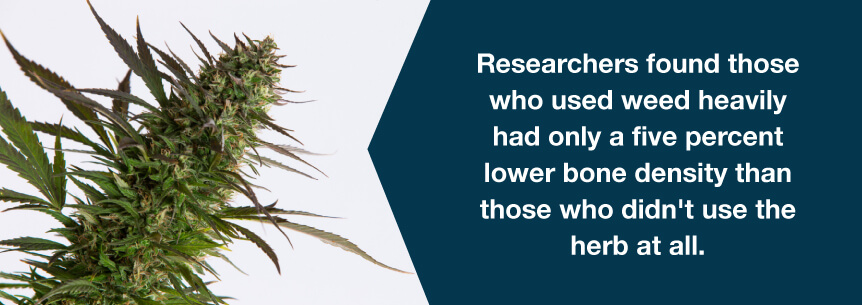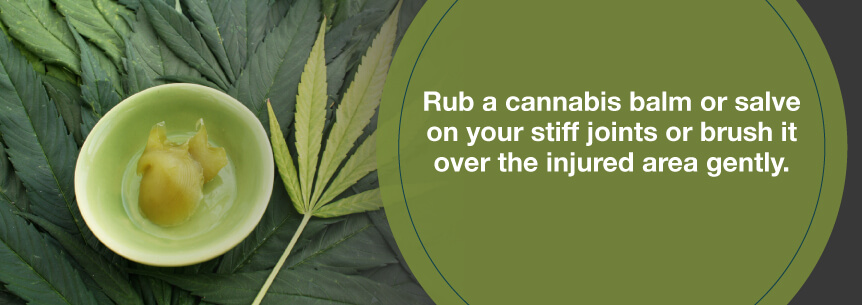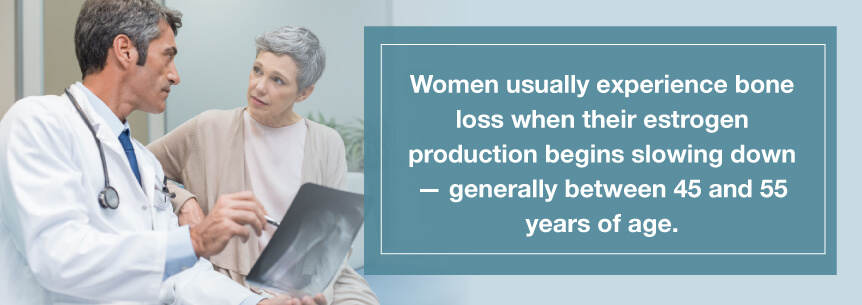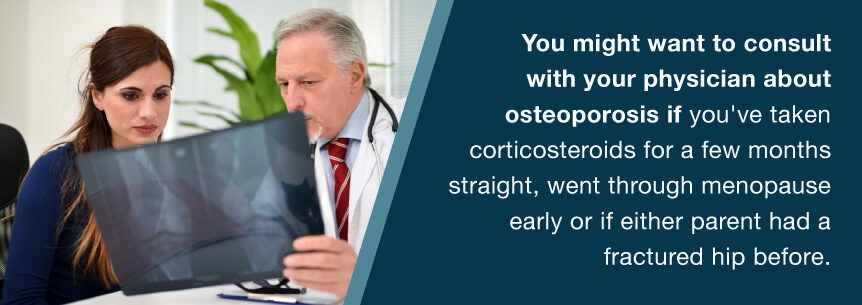The term osteoporosis refers to “porous bones” and is linked to the aging process. It’s a disorder where your bones lose their mass and mineral content and become more fragile and susceptible to fractures. Studies, as you’ll see below, show medical marijuana as osteoarthritis treatment helps lower your risk of osteoporosis and strengthens bone tissue.
Although legalization for medical marijuana is being welcomed in many states, there are increasing concerns this legalization will increase the drug’s recreational use and expose people to more potential health risks, such as increasing the risk for bone fractures, reduced bone density and an increased risk of osteoporosis. However, researchers found those who used weed heavily had only a five percent lower bone density than those who didn’t use the herb at all.
Find A Doctor Find A Dispensary

They did account for numerous other factors, too, that potentially affect an individual’s bone health, such as:
And, for the study, they defined “heavy cannabis use” as smoking the herb over 5,000 times during a lifetime. So, in this study alone, this averages out to where the heavy users smoked the herb over 47,000 times in their lifetime. Moderate cannabis users in the study smoked the herb around 1,000 times during their lifetime and it didn’t look to the researchers as though cannabis had any impact on bone health.
On the flip-side, according to newer studies, CBD, THC and CBG help accelerate bone healing, slow bone degeneration and prevent diseases. Marijuana and osteoarthritis treatment helps control osteoporosis and arthritis pain. Your endocannabinoid system (ECS) plays a significant role in growing, strengthening and preserving your bones. As CB1 and CB2 receptors interact with your body’s other biochemical networks, like your immune system, they become active against bone disease.
During the study, the researchers injected CBD and THC or straight CBD into rats with broken thigh bones. While THC didn’t show a whole lot of effect as far as making the self-healing mechanisms of the body speed up, pure CBD did. The researchers noticed the CBD-treated rats’ bones didn’t heal quicker, but because of a strengthened fracture callus, their previous fracture became less likely to encounter a future break. According to the study, the treated bone is up to 50 percent stronger than the bone not treated.
While cannabinoids do show to be therapeutic and beneficial in helping with bone injury recovery and preventing osteoporosis and other bone diseases, cannabis and osteoporosis treatment may also be a helpful pain management mechanism. Some other ways medical weed may help are with:
Some good cannabis and osteoporosis strains to try to combat these above symptoms and others include:
For Pain:
For Inflammation:
For Trouble Sleeping:
For Depression:
For Anxiety:
If you’re searching for pain relief following a cartilage tear, fracture or osteoporosis symptoms, below is a few administration methods you may find helpful:

So you’re all set and ready to begin your cannabis and osteoporosis treatment as soon as possible. No problem — just visit our marijuana-friendly doctor database to see which one you’ll feel more comfortable building a doctor/patient relationship with.
Once you find a medical marijuana doctor, get your recommendation letter from them and then browse through our extensive list of cannabis dispensaries to find your tailored medical weed treatment for your osteoporosis symptoms.
Find A Doctor Find A Dispensary
Osteoporosis is a disorder defined by reduced bone density, which decreases bone strength and results in fragile bones. The disorder causes irregularly porous and compressible bone — similar to a sponge. It’s a skeletal disorder that weakens your bone and leads to frequent bone breaks or fractures.
Before reaching the point of osteoporosis, you first have osteopenia — a bone disorder where the bone is not as dense as normal bone but isn’t quite at the point of bone in osteoporosis.
Your normal bone is made up of collagen, calcium and protein, all of which provide your bone with its strength. Bones affected by osteoporosis can fracture or break with just a minor injury that typically doesn’t cause a fractured bone.
The fracture or break can either occur in a “cracking” form, like with a fractured hip, or a “collapsing” form, like in a spine or vertebral compression fracture. Your hips, ribs, spine and wrists are all osteoporosis-susceptible bone fracture areas, but fractures related to osteoporosis may also occur in just about any skeletal bone.
Osteoporosis has numerous causes including:
Medical experts categorize osteoporosis into four primary types:
Let’s explore all four.
Primary osteoporosis is the main osteoporosis type. Women get it more often than men. You reach your peak bone density (mass) at around 30 years old. Then, your bone loss rate increases slowly as your bone building rate decreases. Specific factors determine whether or not you develop osteoporosis. These factors are:
An accelerated bone loss in women typically starts after they’ve stopped their monthly menstrual period. Women usually experience this when their estrogen production begins slowing down — generally between 45 and 55 years of age.

Men’s gradual thinning of bone normally begins at around 45 to 50 years old when their testosterone production starts slowing down. Individuals aren’t usually affected by osteoporosis until after they’ve reached the age of 60 years old or older. It tends to impact women earlier than men since they first begin with lower bone density (mass).
Secondary osteoporosis shares similar symptoms as primary osteoporosis. However, certain medical conditions usually trigger it, including:
Taking certain medications known to break bone down can cause it, such as high-dose inhaled or oral corticosteroids, aromatase inhibitors or high-dose thyroid replacement. Anyone at any age can develop secondary osteoporosis.
This type of osteoporosis is rare. Children between the ages of eight and 14 years old develop it, or during times when they’re experiencing quick growth. Causes for this osteoporosis type, where there’s excessive bone loss or too little bone formation, aren’t known. Idiopathic juvenile osteoporosis raises fracture risk.
Another rare osteoporosis form, osteogenesis imperfecta is present at birth. It causes the breakdown of bones for no apparent reason.
Paleopathologists found osteoporosis in ancient skeletons and doctors and scientists today have discovered osteoporosis risk factors, but aren’t sure of the link, making it harder to explain past osteoporosis causes.
Jean Georges Chretien Frederic Martin Lobstein, the French pathologist, found some bones of patients were impaired with holes larger than normal in the 1830s — coining the osteoporosis (porous bone) term to explain this deterioration of human bone.
The condition has been haunting women since ancient times. In fact, scientists have found 4,000-year-old Egyptian mummies with the telltale dowager’s hump. Today, many younger women are anticipating spending their golden years standing up as tall and straight as they are now, thanks to drastic modern improvements in preventing, diagnosing and treating osteoporosis.
The loss of bone leading to osteoporosis develops gradually. Often, you don’t experience any outward signs or symptoms and you may not even realize you have the condition until you experience a minor incident that causes a fracture. It could be a fall or even a sneeze or a cough. The areas commonly affected are:
Spinal breaks can result in posture changes, spine curvature and/or a stoop. Once you have weakened bones as a result of osteoporosis, you’ll likely experience symptoms such as:

You might want to consult with your physician about osteoporosis if you’ve taken corticosteroids for a few months straight, went through menopause early or if either parent had a fractured hip before.
Along with making you more prone to fractures and breaks, osteoporosis may cause other complications as well, such as:
Pain
Osteoporosis-related fractures can be seriously debilitating and painful. Spinal fractures can lead to height loss, persistent neck and back pain and a stooping posture.
Limited Mobility
Osteoporosis can limit your physical activity and be disabling. A lack of activity can increase bone stress, especially in your hips and knees, and cause you to gain weight. Weight gain can also increase your risk of other complications like diabetes and heart disease.
Depression
Osteoporosis can also cause emotional distress. Depression is common in individuals with osteoporosis. Once you receive your diagnosis, it can change your self-image. Your image may seem more fragile than before. Once you’ve broken a bone, you may fear falling and injuring yourself again and therefore stop participating in activities you enjoy.
A changed body image can lower your self-esteem. A lack of physical activity may lead to isolation and a loss of independence. Activities you enjoyed before might be too painful to engage in now, and when you add in a fear of fractures, you may find yourself fighting with depression as well. Being in a poor state of mind can even further impede your ability to handle health problems.
According to the Osteoporosis Foundation:
The goal of osteoporosis treatment is to reduce bone loss and prevent bone fractures by increasing bone strength and density. While detecting the disorder early and treating it right away can decrease your risk of bone fractures in the future, there’s still no definitive cure for osteoporosis. It’s hard to rebuild bone entirely weakened by osteoporosis. This is where prevention comes in.
Lifestyle Changes
To prevent osteoporosis, you need to make some lifestyle changes, including:
Medications
Your doctor may prescribe you medications to increase bone strength and stop bone loss, such as raloxifene (Evista), alendronate (Fosamax) and ibandronate (Boniva). Common side effects of these types of medications may include:
Your doctor may also prescribe medications such as teriparatide (Forteo) to help enhance bone formation. Potential side effects of these types of medications may include: